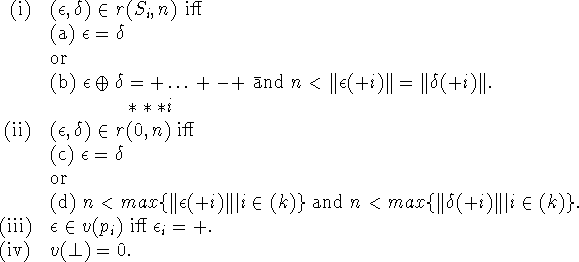
where
We will treat this puzzle by assuming that there are
![]() married couples in the country. Then
the language L = (Pr, Sp, T) adequate for this puzzle will be:
married couples in the country. Then
the language L = (Pr, Sp, T) adequate for this puzzle will be:

where ![]() denotes ith husband,
denotes ith husband, ![]() means that
means that
![]() 's wife is unfaithful and
's wife is unfaithful and ![]() denotes
ith day.
denotes
ith day.
Let ![]() denote that k-fold cartesian
product of the vector space
denote that k-fold cartesian
product of the vector space ![]() with addition
with addition ![]() . We define
. We define
![]()
by ![]() ,
where
,
where ![]() and
and ![]() denotes
denotes
![]() , resp.). We put
, resp.). We put ![]() and
and
![]() .
We also use
.
We also use ![]() to denote arbitrary element in
to denote arbitrary element in ![]() .
Now, let
.
Now, let ![]() denote what the King publicized on the first day, and
denote what the King publicized on the first day, and
![]() denote a knowledge base
for
denote a knowledge base
for ![]() under the situation
under the situation ![]() .
Let us put:
.
Let us put:
![]()
and
![]()
where ![]() . We also put
. We also put ![]() .
Then, as a formalization of the puzzle, we postulate the following
identities:
.
Then, as a formalization of the puzzle, we postulate the following
identities:


Since the meta-notions such as knowledge base and provability ![]() cannot be expressed directly in our language, we were forced
to interpret the King's decree into
cannot be expressed directly in our language, we were forced
to interpret the King's decree into ![]() in a somewhat indirect
fashion.
in a somewhat indirect
fashion.
Now, if we read Eq(*) as the definition of ![]() , then
we find that the definition is circular, since in order
that
, then
we find that the definition is circular, since in order
that ![]() may be definable by Eq(*) it is necessary that
may be definable by Eq(*) it is necessary that
![]() are already defined, whereas
are already defined, whereas
![]() are defined in terms of
are defined in terms of ![]() in
in ![]() .
So, we will treat these equations as a system
.
So, we will treat these equations as a system ![]() ,
, ![]() ,
,
![]() of equations with the unknowns
of equations with the unknowns
![]() and
and ![]() .
We will solve
.
We will solve ![]() under the following conditions:
under the following conditions:
(*) For any ![]() ,
, ![]() is consistent.
is consistent.
(**) For any ![]() and
and ![]() ,
, ![]() is
a knowledge base for
is
a knowledge base for ![]() .
.
We think these conditions are natural in view of the intended
meanings of ![]() and
and ![]() .
.
Let us define a norm on
![]() by
by ![]() ,
where
,
where ![]() .
For any
.
For any ![]() and
and ![]() , we put
, we put

and for any ![]() , we put
, we put

We also put ![]() .
.
We define a KT5-model ![]() as follows:
as follows:

Then we have the following theorem.
Theorem 8. Under the conditions (![]() ) and (
) and (![]() ),
),
![]() has the unique solution
has the unique solution
![]() ,
where the solution is characterized by the condition:
,
where the solution is characterized by the condition:
![]()
Thus we have seen that ![]() may be regarded as the formal
counterpart of the King's decree in our
formal system. The puzzle is then reduced to the
problem of showing that:
may be regarded as the formal
counterpart of the King's decree in our
formal system. The puzzle is then reduced to the
problem of showing that:
![]()
We note that we can moreover prove the following:
![]()
It is clear that ![]() and
and ![]() follow at once from the condition stated
in theorem 8.
follow at once from the condition stated
in theorem 8.